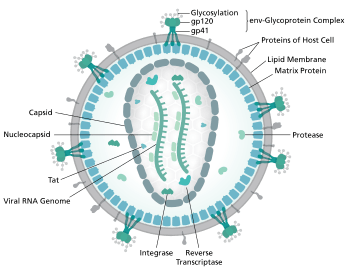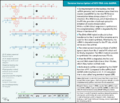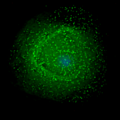HIV facts for kids
Quick facts for kids Human immunodeficiency virus |
|
|---|---|
 |
|
| Diagram of HIV structure | |
| Virus classification | |
| Group: |
Group VI (ssRNA-RT)
|
| Family: | |
| Genus: | |
| Species | |
|
|
The Human immunodeficiency virus (HIV) is a tiny germ called a virus. It is a special type of virus known as a retrovirus. HIV attacks the human immune system. This system is like your body's army. It helps you fight off illnesses and stay healthy.
HIV can lead to a serious condition called AIDS. AIDS is a group of diseases and symptoms. HIV causes AIDS by slowly destroying important white blood cells. These cells are key parts of your immune system. Without them, your body struggles to fight off infections.
Contents
What is HIV?
HIV stands for Human Immunodeficiency Virus. It is a very small living thing. Viruses are so tiny you need a special microscope to see them. HIV specifically targets humans. It weakens the body's ability to protect itself.
There are two main types of HIV. These are HIV-1 and HIV-2. Both types can cause AIDS. HIV-1 is found all over the world. HIV-2 is mostly found in West Africa.
How HIV Affects the Body
When HIV enters the body, it looks for certain white blood cells. These cells are called T-cells. T-cells are like the commanders of your immune system. They tell other cells how to fight off germs.
The Virus's Attack Plan
HIV gets inside these T-cells. Once inside, it uses the cell's own machinery to make many copies of itself. This process slowly damages and kills the T-cells.
Over time, the number of healthy T-cells in the body drops. This makes the immune system weaker and weaker. It becomes harder for the body to fight off even common colds or flu.
What is AIDS?
AIDS stands for Acquired Immunodeficiency Syndrome. It is the most advanced stage of HIV infection. A person is diagnosed with AIDS when their immune system is very damaged. This means they get serious infections or certain types of cancers. These are called "opportunistic infections." They take advantage of a weakened immune system.
People with AIDS can get very sick from germs that a healthy person could easily fight off. Thanks to modern medicine, many people with HIV can live long, healthy lives. They can prevent their infection from turning into AIDS.
Living with HIV
Today, there are special medicines to treat HIV. These medicines are called antiretroviral therapy (ART). ART helps people with HIV stay healthy. It also helps them live longer lives.
ART works by stopping the virus from making copies of itself. This helps keep the number of T-cells high. It also keeps the immune system strong. People on ART need to take their medicine every day. Regular check-ups with a doctor are also very important.
Scientists are always working to learn more about HIV. They are looking for new and better treatments. They are also trying to find a cure for HIV.
Images for kids
-
Reverse transcription of the HIV genome into double-stranded DNA
-
HIV assembling on the surface of an infected macrophage. The HIV virions have been marked with a green fluorescent tag and then viewed under a fluorescent microscope.
-
Left to right: the African green monkey source of SIV, the sooty mangabey source of HIV-2, and the chimpanzee source of HIV-1
See also
 In Spanish: Virus de la inmunodeficiencia humana para niños
In Spanish: Virus de la inmunodeficiencia humana para niños








